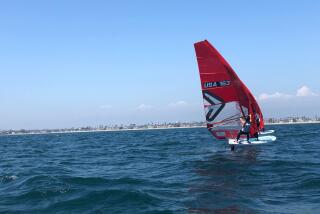They Sail FOR THE Hull of It
- Share via
OXNARD — The old boats have a music all their own.
Wooden masts creak differently than those made of aluminum.
“Just the right creaks,” one sailor said.
Hulls built of wood have a resonance across the water, a solid intonation.
“The wooden boats are alive,” another sailor explained. “Fiberglass is dead.”
Today, a few dozen wooden-boat aficionados will gather at the Corinthian Pacific Yacht Club, as they do every August, to make their brand of music. They will compete in the 20th annual Corinthian Classic Yacht Race which, truth be told, is not much of a race.
“Not a ‘Beat the living daylights out of your competitors’ deal,” said Louise Ann Noeth, the event’s publicist. “If you’ve ever been to a fancy car show, this is a fancy boat show. But, instead of being stagnant, they go out and have a little fun with their boats.”
To qualify, the boats must have been designed before 1952. They range in size from 17 to 70 feet, including sloops, cutters, ketches, yawls and schooners.
Some owners have rebuilt their vessels from stem to stern or, in one case, constructed a new boat using traditional materials and an authentic design.
Others have nursed their boats along, sanding and painting and varnishing, patiently searching for replacement parts when something has broken beyond repair.
“It makes you feel good when people look and say, ‘Gee, that’s a good-looking boat,’ ” said Dick McNish, who owns the Cheerio II, a 56-foot yawl built in 1931. “That’s the point of all this.”
It was McNish who established the Corinthian Classic two decades ago. He wanted to provide a meeting place for people of similar passion. And it is a passion.
These sailors have a motto, a line penned by a magazine writer, that goes something like: “If you have a fiberglass boat instead of a wooden boat, it’s like having a mannequin for a best friend.”
So McNish spread the word and laid out a 17-mile course. He intended for the race to be a mixture of competition, parade and party.
Over the years, the Corinthian Classic has become one of four major wooden-boat races on the West Coast. Sailors make the summer pilgrimage to Channel Islands Harbor, coming from as far as San Diego and San Francisco.
There’s Volunteer, a 70-foot schooner the Navy used to patrol for submarines off the coast of California during World War II. It was also the boat used for the television series “Quincy.”
Bloodhound, a 70-foot cutter, was built just four years ago from an 1890s design.
McNish proudly shows his Cheerio II, once owned by Errol Flynn.
Armand and Kym Renga sail down from Santa Barbara in Charity, a 38-foot ketch that was one of last year’s winners.
“You get to know everyone and their boats,” said Armand Renga, who has brought a number of classic yachts to the race over the past 15 years. “We see each other once a year and it’s a good reason for people to trim up their boats.”
As soon as the boats arrive, many on Friday afternoon, the owners begin perusing each other’s work, Noeth said.
The dock is transformed into a kind of nautical swap meet.
“They will say, ‘I’ve been looking for this cleat or that winch,’ ” she said. “Someone may know someone else who has it.”
Better yet, one of the sailors may walk over to his boat, dig through a locker and say: “Is this what you’re looking for?”
As for the race, it begins at noon from the detached breakwater off Channel Islands Harbor.
The boats head south for three miles to an oil island, reverse direction and sail north to a buoy off the Ventura marina. From there, the course follows the coast, more or less, back to the harbor.
There is a handicapping system, the slower boats starting first. Of course, slower is a relative term among this group.
“These are heavy boats,” McNish said. “It takes some wind to move them.”
The yachtsman, however, was quick to add, “Wood gives you a firmer ride. The modern-day plastic boats, they don’t cut through the water the way we do.”
Waiting at the finish line are a variety of prizes, honoring everyone from the first to the last to the prettiest. There is also a barbecue.
“This is the best race on the coast,” Armand Renga said. “It’s because of the people. We all have this camaraderie because we’re fanatics.”
More to Read
Sign up for The Wild
We’ll help you find the best places to hike, bike and run, as well as the perfect silent spots for meditation and yoga.
You may occasionally receive promotional content from the Los Angeles Times.







